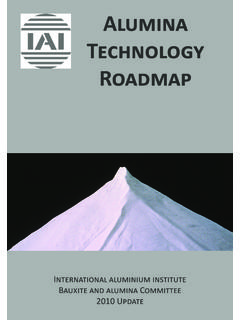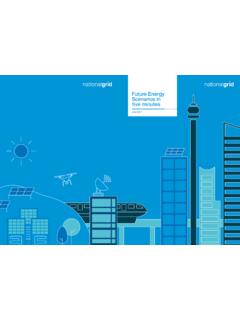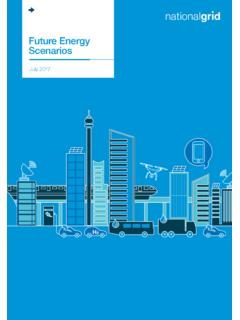Transcription of LCA model of Chinese Grid Power and Application ...
1 A life-cycle model of Chinese grid Power and its Application to the life cycle impact assessment of primary aluminium Abstract: Primary aluminum production is energy intensive due to the large amount of electrical Power consumed in the unit process electrolysis . In the life cycle analysis of primary aluminium, environmental impact can therefore be heavily affected by indirect greenhouse gas emissions (among other impacts) from the consumption of thermally generated Power . This study outlines the development of a life-cycle model of Chinese grid Power at national level, further developed into regional and provincial levels to better assess the cradle-to-gate life cycle impacts of primary aluminium production in China.
2 The results suggest that the contribution to the impact category of global warming potential by electrical energy consumption in the electrolysis process in China is on average around 13 kg CO2-eq per kg of aluminium. 1. Introduction The International Aluminium Institute (IAI) regularly publishes life cycle inventory data from primary aluminium production, as well as environmental impact data based on such Life Cycle Inventories (LCIs1). The last decade has seen a significant increase in the global share of thermal (in particular coal) Power consumed in the production of primary aluminium, driven predominantly by the strong growth in production in China.
3 This in turn has had a significant impact on the environmental impact of aluminium production. It should be noted that aluminium Power mixes in different countries and regions can differ significantly from the national or regional grid mix, due to self- generated or contractual arrangements. For instance, the share of coal and hydropower supplying Power to the aluminium industry in China is 90% and 10% respectively, compared to a China national grid mix of 70% and 20%. The calculation of impacts from Power consumption for aluminium should always therefore reflect an industry grid mix.
4 The 1 2015 Life Cycle Inventory Data and Environmental Metrics (2017) 2 IAI has collected and published such data for over 30 years2. Even taking these issues into account, however, the use of third party published background data3 for China Power production, applied to a 90% coal fired grid , has produced environmental impact numbers (represented by GWP) in excess of those expected. These expected numbers are based on a consideration of the fact that most aluminium production in China is now occurring in regions with very new (and therefore more efficient) Power generating capacity and with a quality of feedstock that is higher than other coal-fired regions of the globe.
5 IAI therefore commissioned IKE to develop an up-to-date life cycle model of Chinese grid Power at the provincial level, which allows an aluminium-specific production weighted provincial impact to be developed. While the study looks at Power mixes per province and as we have seen the aluminium industry has Power mixes that are industry specific, the provincial data was felt to be a relatively good proxy for the industrial grid , given that the major aluminium producing provinces (Shandong, Xinjiang, Henan, Inner Mongolia) tend to have relatively homogenous Power sources.
6 Thus, the study is a provincial model that takes account of both technology and Power mix, which can be applied to provincial aluminium production, albeit using a china national average energy efficiency4 to generate a weighted impact number for use in regional and global life cycle impact assessments of primary aluminium. 2. Methodology A national Power grid model was firstly created. Its structure lays the foundation for further development of a regional and provincial Power model . Thermal Power and hydropower accounted for 75% (including coal-fired Power of 70%) and 19%, respectively, of total electrical Power generation in China in 2014, although the aluminium-specific mix in China was 90% coal and 10% hydropower.
7 The model therefore focuses on grid Power generation from thermal energy and hydro Power plants. The functional unit as well as the reference flow is defined as 1kWh of grid electricity transmitted to end users, excluding electricity use phase. 2 Primary Aluminium Smelting Power Consumption (2015) aluminium smelting Power consumption/#map 3 ecoinvent 33/ecoinvent 4 Primary Aluminium Smelting Energy Intensity (2015) aluminium smelting energy intensity/#data 3 Target representativeness 1) Technological representativeness: the life-cycle model and data is mainly5 based on statistics, which represents national averages of thermal Power and hydropower generation.
8 2) Geographic representativeness: 31 provincial, six regional, and one national average data sets are provided separately, with their own shares of Power mix. 3) Time representativeness: 2014. System boundary The Chinese electrical Power system is composed of three main processes: thermal Power generation, hydropower generation, and grid Power mixing and transmission. Each process contains several unit processes as shown in Table 1. Table 1. Processes included in the system boundary main process thermal Power generation hydropower generation grid Power mixing and transmission unit process coal extraction, coal washing, coal transportation, thermal Power generation Hydropower station construction, hydropower generation Power grid construction, grid Power mixing and transmission Chinese electrical Power statistics of 2014 shows the Power generation from nuclear, wind, and solar and other sources account for 2%, 3%, and less than , respectively.
9 For the total electricity generation. In this model , these Power is covered by data sourced from ELCD and ecoinvent. Impact categories Considered impact categories include global warming, acidification, eutrophication, photo-oxidant formation, ozone depletion, and primary energy. Cut-off rules 1) In the collection of unit-process data, an intermediate flow that accounts for 1% or less of the total inputs is cut off; the total cut-off intermediate flows, however, should be no more than 5% of the total inputs. 2) Machinery, minor infrastructure6, and labour input are left out in the life-cycle model .
10 3) Any pollutant flow that accounts for more than 1% of the total environmental 5 85% data is from industry statistics and annual publications; the remaining data is from literature research. 6 Infrastructure of grid and dams are included. 4 emissions is included in the LCI results. Data quality assessment 1) Completeness of foreground data sets is checked via mass balance and comparison with similar data sets. 2) An intermediate flow that accounts for more than 5% for any impact category as well as its upstream process from background database is highlighted for scrutiny.










